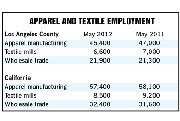Challenges Continue to Stifle California’s Economic Recovery
Retailers this month received a morsel of good news: Gas prices at the pump have fallen off a cliff and are down more than 70 cents a gallon.
That 16 percent drop provides shoppers a little more cash in their pocketbooks to hit the stores.
The bad news is that consumers are still fretting about money, jobs and future taxes. And companies that have been counting on exports to Europe to lift revenues are re-evaluating their export strategies.
San Francisco–based denim maker Levi Strauss & Co. recently reported its second-quarter profits were down more than one-third, with sales in Europe dropping 9.6 percent. In the Asia-Pacific region, Levi’s sales dipped 11.7 percent.
Chip Bergh, Levi’s president and chief executive, acknowledged that Europe continues to be a challenge while sales in Asia declined for the first time in two years. “In the face of these tougher economic conditions, we are rationalizing our business, reducing operating costs and focusing our resources on the opportunities that will have the most impact in growing shareholder value,” Bergh said.
Apparel manufacturer and retailer Quiksilver, based in Huntington Beach, Calif., noted that its European sales dipped 6 percent for the second quarter, ending April 30, going from $206.9 million last year to $195.6 million this year. To offset declining European revenues, the surfwear maker is increasing its stake in Brazil, where the economy grew a robust 7.5 percent in 2010 but expanded only 2.7 percent last year.
Europe, with various countries struggling with sovereign-debt problems, is basically in a recession. And China’s robust economy is slowing down because its main export market is Europe, followed by the United States.
In the United States, the economy is slogging along. In June, retail sales rose only 0.1 percent, the worst showing since August 2009. The country’s gross domestic product is expected to rise a modest 2.2 percent to 2.3 percent this year, gaining strength next year to 2.4 percent to 2.6 percent.
And in California, economists are predicting that the rest of the year will be a time of measured expansion.
Robert Kleinhenz, chief economist at the Los Angeles County Economic Development Corp., said this year is a lot like last year, when we had robust growth in the first quarter and then lukewarm growth for the rest of the year. “We are making progress, but it is slow,” he said.
The state unemployment rate will remain near its current 10.8 percent, slipping, maybe, to 10.6 percent, and then dipping to around 9.7 percent next year. Employment in textile and apparel manufacturing is down slightly from last year.
“Everything augurs toward slow, steady growth as we work our way through the unemployment rate,” said Jerry Nickelsburg, senior economist with the UCLA Anderson Forecast, prepared by the UCLA Anderson School of Management. “This is going to take some time to work through.”
Presidential election-year politics and slow job growth are keeping consumers cautious.
Job market
Only 80,000 jobs were added to U.S. payrolls in June after 77,000 new positions were filled in May. That contrasts sharply with the first three months of this year.
“We had 275,000 new jobs in January, 259,000 new jobs in February and then 143,000 new jobs in March. Basically, the first three months were awesome and the last three months were disappointments,” said Esmael Adibi, director of the A. Gary Anderson Center for Economic Research at Chapman University in Orange, Calif.
“There is a lot of debate among [economic] forecasters about whether this is a trend,” Adibi said. “We are in the camp that this is just a hiccup.”
Still, consumers remained worried about a number of things. While most feel fairly secure about their jobs, they are uneasy about whether they will be taking pay cuts as work hours are reduced or if they will have to contribute more to their health-insurance plans.
“The biggest change in consumer sentiment I have seen is that two months ago 16 percent were concerned that they might go from full time to part time. Now 28 percent are concerned about those jobs,” said Britt Beemer, a retail analyst and chairman of America’s Research Group, which periodically polls consumers on their shopping habits and economic mood.
Another worry is whether Congress will extend a payroll tax cut and a Bush-era income-tax reduction that expire at the end of the year. The two tax reductions save $3,000 a year for a family earning $70,000.
Back-to-School season
No one is expecting the Back-to-School season to climb the charts.
“Back-to-School will be very soft,” Beemer said. “More and more parents are telling us they are going to only buy what their kids have to wear.”
He said that three years ago, 6 percent of parents said they would wait until the December holiday season to buy the rest of their children’s school clothes. Two years ago that amount increased to 11 percent, and last year it doubled to 22 percent as parents figured out what was absolutely necessary to buy. “I wouldn’t be surprised if it were as high as 40 percent this year,” the retail analyst said.
About 80 percent of consumers surveyed in June by BIGinsight, a consumer-centric information portal, said the economy will impact their Back-to-School spending plans this year.
Many shoppers will be hitting the Internet to either check out prices or pick up school clothes, the survey found. Thirty-one percent of consumers with school-age children noted they will price compare items while another 17 percent said they will shop online.






















